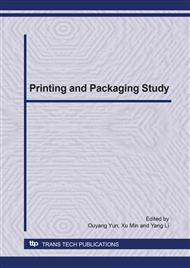p.107
p.112
p.118
p.123
p.127
p.132
p.136
p.140
p.144
A Study of Digital Watermark Algorithm Based on HVS for Halftone Images
Abstract:
Special printing material and special techniques are used for the purpose of fighting against the piracy of the presswork. But these methods require high standard technology and high production costs. Using digital watermark can guarantee a strong and low cost protection for the presswork. Existing digital watermark algorithms for halftone images are mostly applied to FM (Frequency Modulation) screening and these algorithms usually complete the embedding process by modulating the coefficients of the frequency domain. Such algorithms are relatively complex, and they are easy to lose information so that it will make a lower detection probability. Moreover, in the actual printing process, AM (Amplitude Modulation) screening is the more mature and more widely used method compared with FM screening. The subject of this article is monochrome presswork generated by AM screening. The structure of this article is as follows: The first section uses the principle of HVS (Human Visual System) model to select the area in which the watermark will be embedded. The second section uses different screening threshold matrixes to create the printing dots in the selected area. In this way, a texture of certain direction is formed. The last section uses Fourier Power Spectrum method to detect the texture features of the screened image to complete the detection of the watermark. The result of the experiment shows that this algorithm can generate a digital watermark of good transparency and high detection effectiveness. It combines a unique AM screening approach to complete the embedding process. All the processes do not require any additional equipment, and the embedding and detection process are quite simple.
Info:
Periodical:
Pages:
127-131
Citation:
Online since:
December 2010
Authors:
Keywords:
Price:
Сopyright:
© 2011 Trans Tech Publications Ltd. All Rights Reserved
Share:
Citation:


